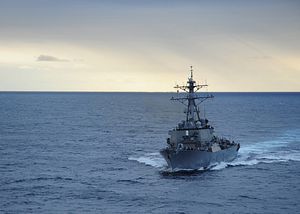On Sunday, two U.S. Navy Arleigh Burke-class guided missile destroyers, USS Stethem and USS William P. Lawrence, transited the Taiwan Strait in what officials described as a “routine” development. Beginning in 2018, U.S. Navy transits of the Taiwan Strait have increased in frequency, drawing criticism from China.
Sunday’s transit is notable for coming just days after China reacted sharply to a transit by a French warship. Following that incident, China withdrew France’s invitation to the Chinese People’s Liberation Army Navy’s 70th anniversary commemoration at Qingdao, though Beijing did not clarify if that was due to the transit specifically. Following that incident, a Chinese Ministry of Defense spokesperson also claimed, for what appeared to be the first time, that the Taiwan Strait represented “Chinese waters.”
That claim was later removed from an official transcript of the spokesperson’s remarks on the Ministry of Defense’s website. The U.S. decision to conduct a transit so soon after France-China incident may have the effect of allowing China to clarify its position on the matter. Under customary international law and the United Nations Convention on the Law of the Sea, most of the Taiwan Strait, with the exception of the 12 nautical mile area off the coasts of Taiwan and China, is available for the free navigation of military and commercial vessels.
“The ships’ transit through the Taiwan Strait demonstrates the US commitment to a free and open Indo-Pacific,” Cdr. Clay Doss, a spokesman for the Navy’s Seventh Fleet said in a statement following Sunday’s transit. “The US Navy will continue to fly, sail and operate anywhere international law allows,” he added.
Even as most of the Taiwan Strait is available for navigation, the militaries of China and Taiwan avoid crossing the median line. That norm between the two sides was challenged at the end of March when two People’s Liberation Army Air Force J-11 fighters “violated the long-held tacit agreement by crossing the median line of the #Taiwan Strait,” according to Taiwan’s Ministry of Foreign Affairs in a statement issued on Twitter.
Tensions between Beijing and Taipei have intensified since the 2016 election of Tsai Ing-wen, who hails from the independence-leaning Democratic Progressive Party. While neither Tsai nor her Party officially support independence, Beijing was not satisfied with Tsai’s endorsement of the so-called “1992 consensus,” which, in China’s view, governs the cross-strait consensus, during her inauguration. As a result, ties have worsened between the mainland and Taiwan; Beijing has additionally plucked away several of the few remaining countries that maintain official diplomatic ties with Taiwan since 2016.
April 2019 also marks the 40th anniversary of the 1979 Taiwan Relations Act, the U.S. law that was passed by Congress following the Carter administration’s decision to formally establish diplomatic relations with China. The Taiwan Relations Act calls on the United States “to resist any resort to force or other forms of coercion that would jeopardize the security, or the social or economic system, of the people on Taiwan” and to support Taiwan “with arms of a defensive character.”
USS Stethem, one of the destroyers involved in the transit, was recently announced by the U.S. Navy as having completed its ongoing deployment with the 7th Fleet. It will return to San Diego for midlife modernization and maintenance.

































